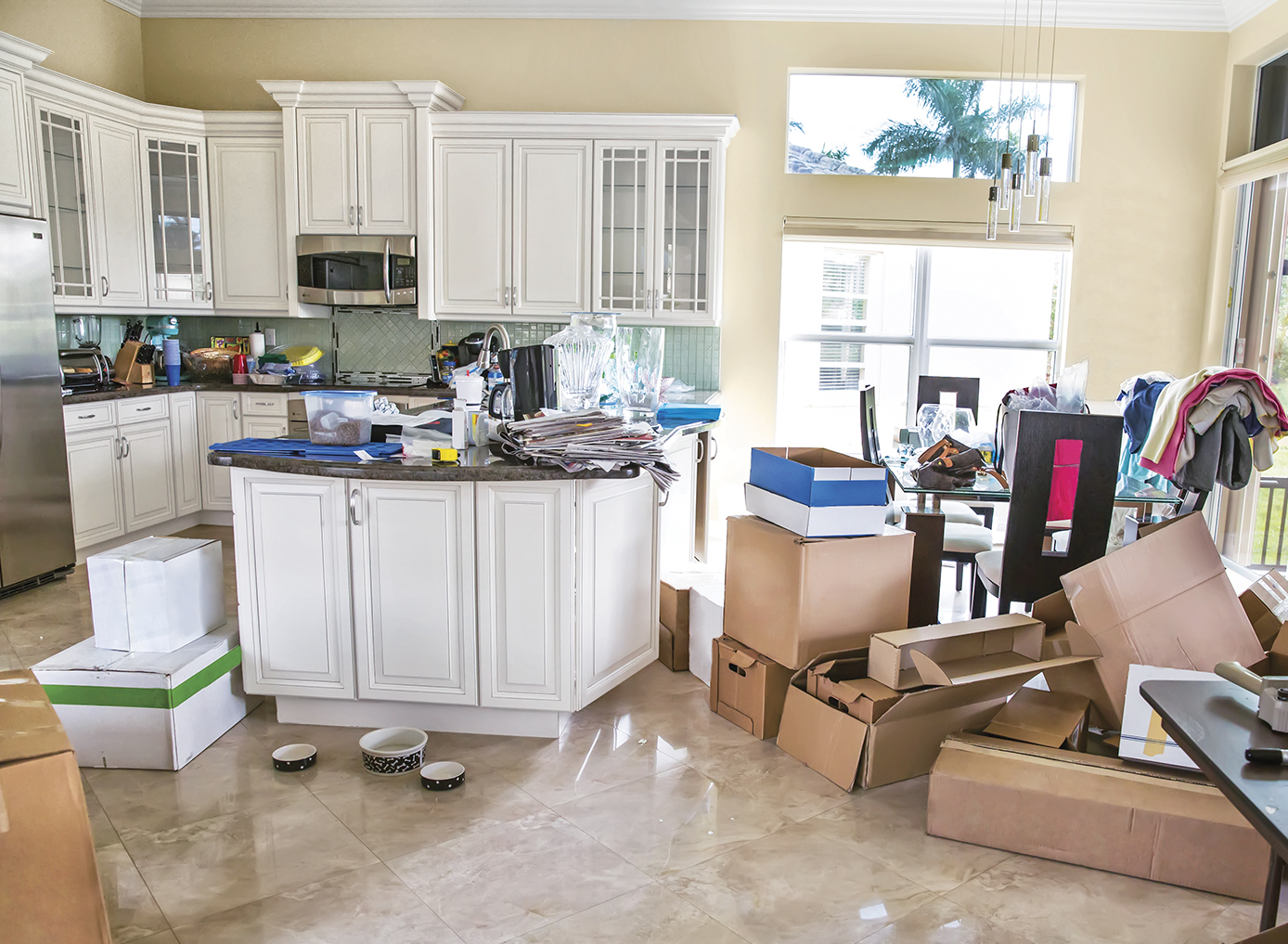It’s true that the process is no fun, but you’ll feel so much better afterwards
By Lola Augustine Brown
You’ve sold the family home and are ready to move into the condo of your dreams. Fantastic. Except that now you’re going from a living space of 4,000 sq. ft. to 900 sq. ft. and you have all this…stuff!
You need to downsize and you’re dreading it. No wonder—you’re looking at weeks and weeks of physical and emotional toil. It must be done, though, and when it is, you’re going to feel amazing. We’ll explain how to tackle this monumental job and some of the things you need to know before you begin.
When to Begin
As you may well already know, getting rid of stuff is a hot topic right now. Two recent bestselling books have helped people shed the weight of useless stuff and create simpler lives.
The first, The Life-Changing Magic of Tidying Up: The Japanese Art of Decluttering and Organizing by Marie Kondo (Ten Speed Press, 2014), urges people to keep only those objects in their lives that spark joy. The second, The Gentle Art of Swedish Death Cleaning: How to Free Yourself and Your Family from a Lifetime of Clutter by Margareta Magnusson (Scribner, 2018), focuses on taking responsibility for all that you will leave behind instead of leaving it for your loved ones to deal with.
Both books discuss decluttering as a process. Magnusson, an 83-year-old artist, declares that we should start at 65 no matter our health and keep on cleaning up our lives as we age. Kondo sees it as a skill we should teach our kids to use throughout their lives. These incredibly popular books question the reality we live with: that most of us are drowning in stuff and it doesn’t make us happy.
“There are more of us living alone, but we have all this stuff and all this room to put it in for most of our lives. I believe we are burdened by our abundance and it causes us so many problems,” says Colette Robicheau, a Halifax productivity coach and professional organizer.
Before you start getting rid of things, you might see decluttering as a simple task, but people get stuck and often need help. Consequently, you’ll find a growing number of professional organizers in every city across Canada who specialize in helping people through the process.
Colette Robicheau advises starting as early as possible and tackling the easiest stuff first, whether that’s clothes or something else.
“If you just walk through your house and say, ‘I’m getting rid of everything I don’t like,’ that’s a start. Often I’ll challenge my clients by saying, ‘Why do you have a wedding dress and wedding gifts from a marriage to someone you divorced years ago?’” A big part of her job, Robicheau says, is giving people permission to let go of things, such as gifts they don’t particularly want but feel guilty about tossing. “We’re conditioned to think that if someone gave us something, we have to keep it,” she says. “But we don’t have to keep things in our lives that aren’t serving us, whether that means things or people. We need to challenge ourselves on this.”
Accept That It’s Stuff, Not Treasure
One of the hardest things to come to terms with when you begin whittling down your worldly possessions is that nobody else wants your stuff. You likely won’t be able to sell most of it, even things that you thought had significant value, and not even your kids are going to want to take it off your hands. The decluttering trend may be a part of the reason.
“Because so many people are decluttering now—seniors included—there’s a glut of china, figurines, crystal, and that sort of thing on the market. Consequently, the value of all those things has really plummeted,” explains Kim Diamond, a Toronto professional organizer and owner of Clutterfly.
Additionally, a lot of the things that people have accumulated are things that the younger generations simply aren’t interested in. “Royal Doulton figurines, for example, used to be worth a couple of hundred dollars, but now if you get $20 for one, you’re doing well,” Diamond says. “Young people don’t want these things, and that’s something that’s reflected in wedding registries—people aren’t signing up for china. They don’t want those big hulking pieces of furniture like sideboards and china-hutches. The only exception is teak stuff from the ’70s—that mid-century-modern stuff never goes out of style.”
As for passing things on to your family members, be prepared for the possibility that they might not be interested. It isn’t a personal attack when your kids don’t want your things. Most of us have our own taste and like our own stuff, and it’s unrealistic to expect that younger generations are going to love our things the way that we do.
“We have curated our homes with things we love and have attached memories to these objects,” Robicheau says. “Every one of the hundreds of times we’ve touched them, we’ve built a stronger bond with them. Our kids don’t feel the same way about those things or have that sentimentality, and most are space-poor, without the room to take these things.”
So if you love somebody, set them free from your stuff. They have their own stuff, and probably too much of that already.
The Old Heave-Ho
If you do want to sell a significant amount of stuff, it’s a good idea to consider contacting a local auction house to do it for you. “Often they want only the best of the best of your things, but sometimes they’ll take the whole lot,” Robicheau says. “They’ll come and take it away so that you don’t have to organize the selling of anything. This is important because you may not want random people coming to your house on the pretense of buying something and casing the place while they’re there.”
Ted and Joanne Ewart of Saskatoon were ruthless when they moved from their home to a condo because they’d had trial runs, having had to downsize both of their parents’ houses. “We had a three-day garage sale and priced everything we didn’t want at $2 or less, even large casserole dishes, everything. We had so much fun doing it, talking with all our neighbours who came by,” Ted says. “We made $1,800, and could have probably made more if we’d priced things higher, but the point was to sell it all quickly.”
There are places that will take your stuff for free, though, and you might give some thought to who needs what before you start. When Bernadette Walsh of St. John’s, NL, had to declutter both her own home and the six-bedroom home that had belonged to her parents in order to move into a two-bedroom condo, she tackled the job armed with a list.
“I knew that a local animal shelter needed towels, sheets, and blankets, and that a homeless shelter in town could use the clothes,” Walsh says. She also made an arrangement with one local charity whereby it would come by to pick up boxes of miscellaneous stuff every Thursday morning for three weeks. This was a clever motivational tool: “The first week, I had three boxes, but by the last, there were 20 packed up to be collected.”
Be Realistic About Your New Space
Many people feel they’ve done a great job of downsizing until they get a wake-up call when they move into their new place and have to start another round.
You need to consider the floor plan that you’ll be working with and think realistically about your future needs. Hint: If you took that dinner service for 12 out of the box twice in the past decade, you likely don’t need it in your condo.
“Most of the time, people fail to get rid of enough stuff because they’re guessing at how much will fit in their new place and they end up having to do a secondary purge when they move,” Diamond says. “This is especially difficult for those with a deep sentimental attachment to their stuff. It is almost as if they have to see it to believe it.”
When Danyelle Boily of Toronto moved from an 1,100 sq. ft. house to a 495 sq. ft. condo, she found that much of what she had simply wouldn’t fit. “I developed the theory that if I was taking a piece of furniture, it had to serve a dual purpose. My dining table had to work as a desk, for example,” Boily says. Although it was hard to let go, she turned buying smaller and more appropriate pieces for her tiny new home into a fun challenge.
Stumbling Blocks
Even if you know what you should be getting rid of, it isn’t always easy to let go. Photos can be one of the trickiest hurdles. “In the last five years, a whole new industry has sprung up of people who organize photos for clients, sorting through what you have, digitizing them and getting them into some kind of order,” Robicheau says. “But some people are just wired to be more sentimental, so everything can be an issue.”
Having someone help you deal with this stuff is a great idea, so don’t be afraid to reach out and ask those closest to you. If you’re stuck, a professional can be a good idea.
Diamond says that a mix of people come looking for her help. Some plan well in advance of a move, but at the other end of the spectrum are panicked calls from the adult children of a senior who is moving—and soon. “Those situations are far more chaotic,” she says.
For a standard three-bedroom house, Diamond gives a ballpark figure of between $5,000 and $8,000 for her professional services. The process can take from two weeks to a month—the more time you have, the better.
The more work you do yourself beforehand, the less expensive the process will be. “I always tell people to do as much as they can to get started and then bring me in to get them jazzed to take it to the next level,” Robicheau says.
As daunting as the prospect of downsizing is, the process is well worth the effort. “When we were going through everything, we wondered if we’d miss things, but we really haven’t,” says Ted Ewart, with Joanne adding, “We realized it was all just stuff and nothing we couldn’t live without.”
Decluttering your life takes a load off and enables you to move on to the next phase of your life, unfettered by things you probably haven’t needed in years.
Photo: iStock/JodiJacobson.






